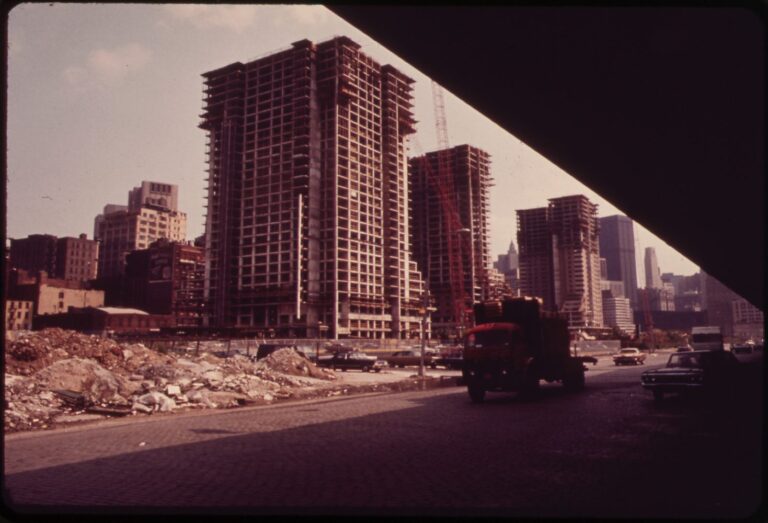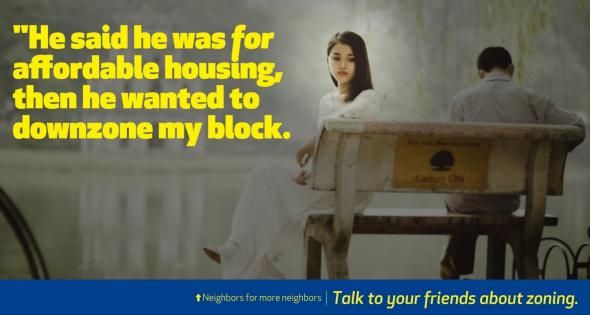Physical Address
304 North Cardinal St.
Dorchester Center, MA 02124
Physical Address
304 North Cardinal St.
Dorchester Center, MA 02124
I recently read a highly publicized pro-NIMBY book, Vanishing New York. The author, who goes by the pen name “Jeremiah Moss” tells a simple story: throughout New York, gentrification and chain stores are on the march, making the city rich and boring. The story has an element of truth: obviously, there are some places that have gentrified, and there are some places (mostly notably Times Square) that have lots and lots of banks and chain stores. But on balance, the book’s relationship with factual reality is a bit uneven. Much of the book complains about the evils of gentrification. But in fact, even in Manhattan the poverty rate is 17.9 percent, about three times that of most New York suburbs. Moss also claims that the city is getting whiter, but even Manhattan is 40 percent black and Hispanic, and New York City as a whole is 54 percent black and Hispanic. By contrast, in 1980 the city was only 45 percent black/Hispanic, and in 1940 it was over 90 percent white. Moss seems to think that the city is being taken over by chain stores. The last time I walked through the East Village (one of the neighborhoods he writes about) I found about one or two such stores per block, or about 5 or 10 percent of all storefronts. My guess is that Moss thinks about chain stores the way many racists think about racial minorities: because they assume one is too many, 5 percent seems to them like a takeover. Moss is all for immigration from foreign nations, but constantly complains about newcomers, especially parents; he uses the word “stroller” like anti-Semites use the term “international bankers”- as a code-word for a dreaded enemy. He has a problem with college students too (complaining about “NYU’s presence… [having] spread […]
(cross-posted from planetizen.com) I have argued numerous times on Planetizen that increased housing supply would reduce rents. I recently read one counterargument that I had not fully addressed before: the claim that no amount of new housing will ever bring down urban rents because housing in high-cost, high-wage cities is expensive to build.* This argument rests on two assumptions: (1) that construction costs are the primary reason some cities are more expensive than others, and (2) if new housing is expensive, the median citywide rent will be equally expensive. I find neither assumption to be persuasive. Admittedly, expensive cities do tend to have higher construction costs than more affordable costs—but this gap is far more modest than the gap in housing costs between high-cost and low-cost cities. For example, a study by the design firm EVStudio showed that the construction costs for a small apartment building in New York City were only about 30 percent higher than the costs of a similar building in Kansas City ($232 per square feet in New York, $181 in Kansas City). But rents in New York are far more than 30 percent higher; I pay about $5 per square foot for my Manhattan apartment, but paid just over $1 per square foot for a roughly comparable apartment in Kansas City (i.e., a doorman building in a fashionable intown neighborhood). Similarly, the Lincoln Institute’s land price database reveals that regional differences in construction costs lag behind differences in land costs: for example, construction costs in San Francisco are only about 60 percent higher than construction costs in Kansas City, but the median San Francisco-area house costs seven times as much due to differences in land costs. Thus, construction costs are not the main reason some cities are more expensive than others.** Moreover, the suggestion that high construction costs for new buildings mean high […]
Ever since zoning was invented in the 1920s, homeowners have argued that limits on density and on multifamily housing are necessary to protect property values. But today, urban NIMBYs seek to prevent new housing on the ground that new housing will lead to gentrification, which will in turn lead to increased property values, which in turn will lead to rising rents and displacement. Similarly, I often read that cities and suburbs shouldn’t have any new housing because they might become “too dense” or “overcrowded.” (Never mind that when there’s not enough housing to go around, excluded residents respond not by leaving the city, but by sleeping on the streets, thus making the city feel even more crowded). But at the same time, I also read that building new housing is futile, because it will all be bought up by foreign oligarchs, who (because they aren’t quite greedy enough to rent out their property) cause the housing to be lifeless and unoccupied. It is not quite clear to me how the city can be overcrowded and undercrowded at the same time, but evidently this view seems to be common.

In a recent blog post, Julia Galef has generated a fairly comprehensive list of pro-housing arguments and counterarguments to those arguments. She gives the most detailed consideration to the “infinite demand” argument- in her words, “So even if SF adds a lot of additional housing, prices will still rise almost as quickly as they would have anyway, as long as demand to live here continues to soar. This view is mainly based on examples of other desirable cities, like New York or Singapore, which have built new housing at a faster rate than SF but nevertheless saw steep increases in price.” To which I respond: New York? Really? New York is only pro-housing when compared to San Francisco- which is a bit like saying Iran is a libertarian paradise compared to the Islamic State. In fact, New York has built housing at a glacial pace. Between 1960 and 1976, the number of new housing units completed per year ranged from just over 14,000 to over 60,000, and exceeded 20,000 in all but four years. In the almost forty years since 1976, the number of new units exceeded 20,000 in only four years (2006-10) and was above 14,000 for only ten years (1989, 2002, 2004-10, 2015). Meanwhile, demand for housing has increased: between 2006 and 2014 alone, the citywide renter population grew by 600,000. A better example of a “desirable city” would be a city where both the population and the housing supply is growing at a rapid rate- Raleigh, for example, or Las Vegas. These cities are much cheaper than New York or San Francisco.* Another example of a cheap, permissive city is Tokyo. But the post suggests Tokyo may not have grown as fast as American cities. In fact, Tokyo’s regional population grew by 17 percent since 1990- from 32.5 million […]
Some people accept the idea that restrictive land use policy is just as bad as all the research suggests, but persist in supporting the status quo. They argue that if a community chooses to regulate its built environment, that choice should be respected as having moral weight because it’s the outcome of a democratic process. This argument, though, is as logically confused as it is normatively problematic. And in the following few lines, I intend to demonstrate exactly why. No decision making process is value neutral. Whatever way we choose to go about collective decision making, we will always privilege certain voices over others. Institutions beget outcomes and the internal logic of our institutions will always favor some outcomes (and therefore voices) over others. The same individuals with the same preferences asked to make the same decisions through different procedures will produce wildly different outcomes. Imagine a U.S. Presidential election based on the popular vote or representation in the U.S. Senate proportional to state population and you should begin to see how the public will is as much a product of procedure as it is aggregated individual preference. Taking the Bay Area as a land use specific example, our system heavily favors the voices of incumbent homeowners to the detriment of everyone else. Land use decisions take place at the municipal level which–given the fact that we have 101 different municipalities–is a hyper local affair. When a new development is proposed, it only takes a handful of angry neighbors to impact decision making. Were land use set at a higher level of government, the typical number of people that get angry over an individual project would be far less effective at killing new housing. Fifty angry homeowners might matter to the Palo Alto City Council, but they’d be quite a […]
One common argument against new urban housing runs as follows: “If we build new housing, it will all be bought up by rich investors who will sit on it. So new supply doesn’t restrain housing costs.” This argument (at least as I have phrased it) strikes me as absurd. Here’s why: for the argument to justify restraining supply, the argument presupposes that if you build 100 new condos/houses/apartments, every single one of them will be bought by an investor, and every single investor will irrationally choose to sit on the unit rather than renting it out. I can’t prove this is wrong, but it seems really hard to believe.* Even leaving aside the logical weirdness of the argument, it seems to have a questionable factual basis. If there was really a wave of nonresident investors in expensive cities, we might find (1) that the most expensive markets had the highest housing vacancy rates and (2) that these vacancy rates have been rising as housing costs rose. But Census data suggests otherwise. Here’s some data: (all for central cities, not metros) Expensive 2010 2015 Manhattan 12.7% 13% San Francisco 9.8 7.9 Los Angeles 6.7 6.5 San Diego 7.8 7.1 Boston 9.1 8.0 Not so Expensive 2010 2015 Dallas 12.8% 10.6% Houston 14.0 12.1 Philadelphia 14.1 13.3 Chicago 13.8 13.2 By and large, the expensive cities have lower vacancy rates- exactly what you would expect in a free market. The only exception is Manhattan. But it seems to me that if pied-a-terres led to higher rents, Manhattan’s empty-house rate would have climbed as rents did- which does not seem to have been the case. The only way to save the “empty house” theory is to suggest that expensive cities’ empty houses are different from everyone else’s – that is, they are especially […]

Last week, I posted about an attack on YIMBYs (activists who favor less zoning and more housing) that used the term “alt-right”; the authors of that blog post recently doubled down with a slightly more moderate op-ed that still tarred YIMBYs as “aligned with conservative right-wing libertarianism.” In fact, the Obama Administration is on the same side as YIMBYs; I recently published an article about their 2016 policy paper on urban housing. Read all about it here.

The far-left “TruthOut” web page recently published an attack on YIMBYs,* describing them as an “Alt-Right” group (despite the fact that the Obama Administration is pro-YIMBY). I was surprised how little substance there was to the article; most of it was various ad-hominem attacks on YIMBY activists for cavorting with rich people. I only found two statements that even faintly resembled rational arguments. First, the article suggests that only current residents’ interests are worth considering in zoning policy, because “the people who haven’t yet moved in” most often means the tech industrialists, lured by high salaries, stock options and in-office employee benefits like massage therapists and handcrafted kombucha.” This statement is no different than President Trump’s suggestion that Mexican immigrants “[are] bringing drugs. They’re bringing crime. They’re rapists.” – that is, it is an unverifiable (if not bigoted) generalization about large numbers of people. Furthermore, it doesn’t make sense. The “tech industrialists” have the money to outbid everyone else, so they aren’t harmed by restrictive zoning. Second, the article states that academic papers aren’t as relevant as the actual experiences of San Franciscans displaced by high housing costs. In response to the argument that less regulation means cheaper housing, it states “tell that to people like Iris Canada, the 100-year-old Black woman who had used local regulations to stay in her home of six decades, only to be evicted in February.” So in other words, somebody was evicted in San Francisco, therefore San Francisco’s restrictive zoning prevents eviction. I don’t see how the latter follows from the former. The whole point of the YIMBY/market urbanist argument is that if there was more housing, there would be lower housing costs, hence fewer evictions. *For those of you who are unfamiliar with the term, YIMBY means “Yes In My Back Yard”, a […]

I just finished reading Richard Florida’s new book, The New Urban Crisis. Florida writes that part of this “crisis” is the exploding cost of housing in some prosperous cities. Does that make him a market urbanist? Yes, and no. On the one hand, Florida criticizes existing zoning laws and the NIMBYs who support them. He suggests that these policies not only raise housing prices, but by doing so harm the economy as a whole. For example, he writes that if “everyone who wanted to work in San Francisco could afford to live there, the city would see a 500 percent increase in jobs… On a national basis, [similar results] would add up to an annual wage increase of $8775 for the average worker, adding 13.5 percent to America’s GNP – a total gain of nearly $2 trillion” (p 27). On the other hand, Florida is not ready to endorse the idea that “we can make our cities more affordable… simply by getting rid of existing land use restrictions” because “the high cost of land in superstar neighborhoods makes it very hard if not impossible, for the private market to create affordable housing in their vicinity. Combine the high costs of land with the high costs of high-rise construction and the result is more high-end luxury housing.” (p. 28). I don’t find his point persuasive, for a variety of reasons. First, as I have written elsewhere, land prices are often quite volatile. Second, the overwhelming majority of any region’s housing is not particularly new; even in high-growth Houston, only 2 percent of housing units were built after 2010. Thus, new market-rate housing is likely to affect rents by affecting the price of older housing, rather than by bringing new cheap units into the market. Florida also writes that “too much density can […]

The alternative title for this piece was: “Ballot Box Zoning: Where Needed Housing Goes to Die.” Next month, Los Angeles will be voting on Measure S, a proposed 2-year policy that will effectively serve as a moratorium on new construction. That is, Measure S will require a public vote on any new development that does not fit within existing zoning. Most of the city’s major leaders, including Mayor Eric Garcetti, have come out against the measure, and the Los Angeles Times followed suit just a few days ago. I’m not going to rehash arguments for or against the measure. Instead, I’m going to offer several warnings based on the experience of Davis, CA, which passed its own Ballot Box Zoning Measure in 2000. Measure J, our ballot box zoning measure, requires voter approval on any attempt to change the zoning designation of open space or agricultural land that sits on the community’s edges. The law also explicitly names two particular parcels that must be voted on prior to approval. So for the purposes of this piece, consider it a ballot box zoning law targeting sprawl. Warning 1: These Measures Are Hard To Roll Back Measure J passed in Davis with just 53.6% percent of the vote in a March primary when residents cast just 19,000 votes (in a city with at least 49,000 voting-age residents). The law contained a renewal clause, and when it came up for renewal in 2010, support jumped to 76.7% percent. This increased support may be an artifact of how the opposition attempted to stall the measure’s renewal. Opponents of the renewal made a NIMBY argument the centerpiece of their case: they argued that slowing growth at the edge of town meant more infill pressure in the city’s core, threatening the character of neighborhoods. As I’ll discuss in a […]